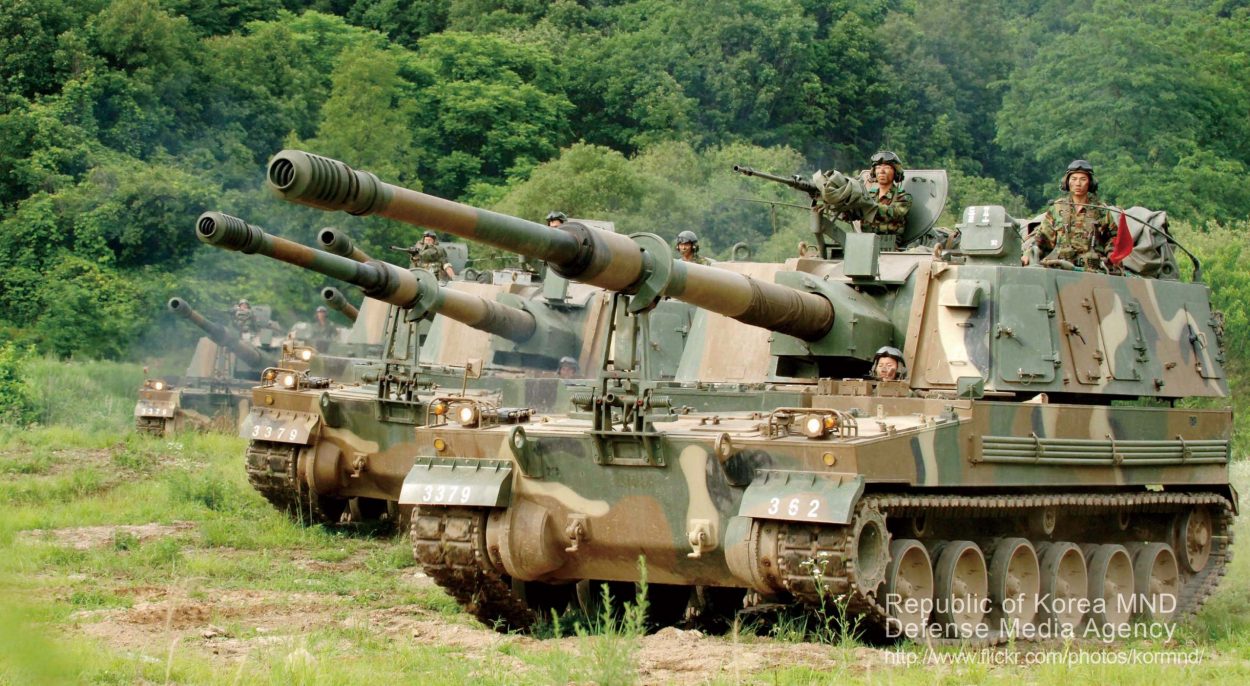After acquiring French Rafale fighters, Egypt is now set to increase its firepower with South Korean K-9 ‘Thunder’ howitzers. Coincidently, India also operates both Rafale fighters and K-9 Thunders locally called the K-9 Vajra.
South Korea struck an over 2-trillion won (US$1.65 billion) deal with Egypt on February 1 to deliver K-9 self-propelled howitzers, Seoul’s arms procurement agency DAPA announced. This is K-9’s largest export contract and a first with an African country.
The contract was signed in the Artillery House, a military facility in Cairo, between Hanwha Defense and Egypt’s Defense Ministry, concluding more than 10 years of discussions.
Official announcement from the Egyptian military ??
– Egypt signed a contract with Hanwha Defense for the production and technology transfer of K9A1 artillery system.
– Egypt signed two MoUs with ?? for mutual cooperation in defense industries and boosting cooperation in R&D https://t.co/qRer47xGW9 pic.twitter.com/WMeDf4BXcg
— Mahmoud Gamal (@mahmouedgamal44) February 1, 2022
The agreement involved local production and transfer of the artillery system to Egypt. The deal came after President Moon Jae-in met with his Egyptian counterpart Abdel Fattah el-Sisi met in Cairo last month, which the Defense Acquisition Program Administration (DAPA) claimed, provided a much-needed push for the agreement’s conclusion. It was the first visit by a South Korean president to Egypt in 16 years.
The decision to supply K-9 self-propelled howitzers to Egypt, according to President Moon’s office in Seoul, is the country’s largest export contract for the weapon. It did not disclose any other information about the deal, including how many howitzers Egypt will receive. However, Defense News speculated that the number of units could be roughly around 200.
Egypt is currently acquiring military hardware at a rapid pace, negotiating arms deals with Western countries besides Russia. Egypt, like India, is acquiring French Rafale fighter jets, while also having Russian fighter jets such as the MiG-29 in its arsenal. India also operates a variant of the K-9 called ‘Vajra’.
Cairo was previously rumored to have placed an order for Russian Su-35 combat fighters. However, it seems the country dropped the idea fearing American sanctions under CAATSA.
Last week, the US Department of State announced a $2.5 billion arms sale to Egypt. The agreement includes 12 Super Hercules C-130 cargo planes and supporting equipment valued at $2.2 billion, as well as $355 million in air defense radar systems.
Reasons Behind The Procurement
Seoul initially began negotiations with Egypt in 2009 but those were put on hold due to the country’s internal turmoil, including the Arab Spring, a wave of pro-democracy protests, uprisings, and civil wars that began in 2011.

The two sides resumed talks in 2017, and a fierce competition ensued for the Egyptian contract between the French Nexter’s Caesar, the South Korean K9 Thunder, the Russian Koalitsiya-SV, and the Chinese PLZ-45.
Earlier, it was reported that the two countries’ representatives discussed the manufacturing of K9 as well as Black Panther tank during the International Exhibition of Defense and Security in Cairo, Egypt, towards the end of 2021.
Egypt currently operates A2, A3, and A5 variants of M109 howitzers and is looking to replace its aging hardware. Abdel Hamid Harfi, a military researcher and author, told Defense News, “Some of these American howitzers are first-generation systems and are either out of service or used by the Egyptian Ministry of Military Production to manufacture local artillery using Russian 122mm guns, but they don’t meet the field efficiency requirement levels the Armed Forces need. After local upgrades, they have become armored and not self-propelled.”
Egypt’s decision to order K-9 Howitzers has a range of factors, mainly a joint production deal. The American howitzer and the K9 Thunder howitzer are pretty similar and the Egyptian armed forces apparently specified this system in terms of cost and technological transfer.
In addition, the system is expected to contribute to Egypt’s national objective of boosting its defense sector by allowing for locally administered maintenance and spare part fabrication.
K9 Thunder Success
With the latest defense deal, Egypt will become the eighth foreign country to adopt the K9 system. Australia has recently signed a contract for 30 K-9 Thunder self-propelled howitzers. Turkey, Poland, India, Norway, Finland, and Estonia are among the countries that have adopted the system. Currently, more than 1,700 K9 variants are said to be operational across the globe.
Turkey signed a deal with South Korea in 2011 for 350 units and has obtained a license to manufacture the T-155 Firtina, a variant of K-9. India also operates K9 Howitzer. Larsen & Toubro of India and Hanwha Techwin (HTW) of South Korea signed a contract in July 2017 to manufacture the K9 155mm/52 Caliber Tracked Self-Propelled Howitzer for the Indian Army under the name Vajra-T, an enhanced version of the K9 Thunder.

Although the K-9 and any modern self-propelled artillery vehicle resemble tanks, they are only lightly armored. They are frequently incorporated as armored fighting vehicles to protect the crew from shrapnel and small arms. Machine guns are also mounted on many of them in order to thwart enemy attacks.
The crew of the K-9 is protected by all-welded steel armor that can withstand 14.5 mm armor-piercing shots, 152 mm shell fragments, and anti-personnel mines. It also provides comprehensive nuclear, biological, and chemical protection.
In MRSI (Multiple Rounds Simultaneous Impact) mode, K-9 can fire three shells in under 15 seconds — one every 5 seconds — each with a different trajectory so that they all hit their target at the same time.
- Contact the author at ashishmichel@gmail.com
- Follow EurAsian Times on Google News




